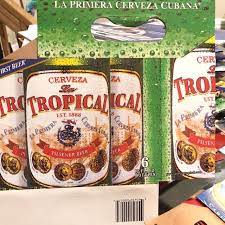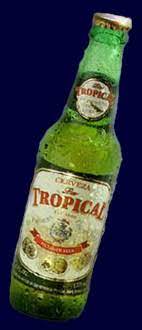HISTORIA DE LA CERVECERIA “LA TROPICAL”. CUBA, UN PAÍS QUE PUDO HABER SIDO Y NO FUÉ…PHOTOS.
Con tecnología estadounidense, lúpulo y cebada importadas de Alemania y agua de un pozo local, “La Tropical” producía una de las mejores cervezas del mundo. Pero eso fue hace mucho tiempo. Dada la situación actual, resulta de ciencia ficción recordar que Cuba históricamente fue un país dedicado a la producción. La industria por ende marcó su desarrollo, su posición ante el mundo, las relaciones sociales establecidas y la conformación de su población, dejando una fuerte huella cultural en la nación.
En una breve revisión histórica veremos que, una vez determinado su carácter estratégico como punto intermedio entre la península española y las colonias americanas de tierra firme, Cuba tuvo que incorporar rápidamente la agricultura y la ganadería. Con esto daba servicio a la flota española durante su permanencia en La Habana, pero también la proveía en su viaje de vuelta a Europa.
COMIENZA EL DESARROLLO DE LA ISLA…
Del desarrollo ganadero derivó la exportación de velas, jabones y cuero, este último como materia prima para la confección de ropa, accesorios, muebles, piezas de maquinarias, etc. Capítulo aparte constituye la explotación minera, que puede considerarse la primera industria del país. Esta se remonta a 1530, con la apertura en Santiago de Cuba de la primera mina de cobre de Latinoamérica.
A partir del siglo XVIII, el azúcar comenzó a ganar importancia aprovechando las excepcionales condiciones naturales que la Isla ofrecía para su cultivo. De este modo, la explotación consciente y especializada de los recursos locales impuso el monocultivo natural de la caña de azúcar, que dominó el panorama industrial cubano hasta muy avanzado el siglo XX. No obstante, Cuba produjo mucho más que azúcar. Su mayor diversificación industrial la alcanzó con el establecimiento de la República, aunque desde finales del siglo XIX puede observarse la incorporación de nuevos rubros dedicados a la satisfacción del mercado doméstico, a partir de entonces mejor abastecido.
Algunas de estas nuevas industrias llegaron a crear verdaderos emporios, gracias a la adecuada planificación de sus recursos financieros y estrategias comerciales, así como por las leyes que entonces apoyaron su desarrollo y de las asociaciones mercantiles creadas para la movilización de los planes y medidas que pudieran favorecerles, y para afianzar las conexiones de la industria y el comercio local.
Un ejemplo de manual fue la Nueva Fábrica de Hielo S.A. (1888). Sus fundadores habían transitado un largo camino de ascenso desde que llegaron, en el siglo XIX, como inmigrantes procedentes de Cantabria. En La Habana trabajaron como dependientes en comercios y almacenes del puerto, hasta convertirse en propietarios de compañías de vapores. La última de ellas fue la Compañía de Vapores Sobrinos de Herrera (1886), dedicada al cabotaje y al comercio con España, EEUU y el Caribe. El inmueble donde radicaban sus oficinas, situadas estratégicamente junto al puerto, es el actual hotel Armadores de Santander.
La Nueva Fábrica de Hielo S.A., fue la segunda industria de su tipo en la capital, pues entonces solo existía La Habanera de Hielo (1878). Con su fundación, incorporó una nueva dinámica competitiva para este producto, y no pasó mucho tiempo para que se convirtiera en la primera y mayor productora y comercializadora de hielo y bebidas del país. Esto lo consiguió gracias a la diversificación de sus productos, lo que le llevó a dominar todos los componentes necesarios de su línea de producción.
FABRICA DE CERVEZA LA TROPICAL…
De esta forma, en 1896 compró la fábrica cervecera La Tropical, situada en Puentes Grandes, instalación que amplió y modernizó, implantando el primer sistema mecanizado de la industria cervecera cubana, que empleaba la energía hidráulica del Almendares. En 1909, absorbió una de las más importantes fábricas de cerveza norteamericana radicadas en Cuba, la Havana Brewery, propietaria de la Fábrica de Cerveza y Hielo Tívoli (1905), de Palatino. A partir de entonces la marca Tívoli comenzó a comercializarse como la segunda más importante de la Nueva Fábrica de Hielo, S.A.
En 1916, construyó en Palatino una fábrica de botellas, envases de vidrio, tapas y coronas, con una capacidad de producción de 90.000 botellas al día. Esta nueva industria le permitió autoabastecerse de todo lo que necesitaba, por lo que dominaba la producción de la cerveza, de su envase y del hielo para enfriarla. Dicha estrategia disparó a gran escala su capital, alcanzando a mediados del siglo XX el séptimo lugar entre las industrias cubanas no azucareras.
En 1911 explotaba más de siete marcas de cerveza entre claras y oscuras: Tropical, Tívoli, Águila, Excelsior, Maltina, Familia, Bola Roja, etc. El 3 de junio de 1928, sacó a la venta la cerveza clara Cristal Palatino; y el 1 de mayo de 1938, la cerveza negra de alta graduación, tipo inglés, La Tropical 50, en conmemoración al cincuentenario de la fábrica. También produjo la Maltina Tívoli vitaminada.
La calidad de la cerveza producida por la Nueva Fábrica de Hielo S.A. fue muy conocida y celebrada, y obtuvo varios primeros premios en exposiciones universales en Inglaterra, Estados Unidos, Alemania, Francia y Bélgica. Para esta industria se contrataron consagrados técnicos y maestros cerveceros alemanes, que consideraban que con la tecnología estadounidense instalada en La Tropical se podía obtener una de las mejores cervezas del mundo. Las materias primas también eran de la mejor calidad. El lúpulo y la cebada, se importaban directamente de Alemania, y el agua, esencial en la fabricación de la cerveza, se extrajo siempre del pozo de San Gerónimo, en Puentes Grandes.
LA REVOLUCION DE 1959 Y CUBA SE DETUVO…
El 13 de octubre de 1960, se le notificó al presidente de la compañía, Julio Blanco Herrera Clavería, la nacionalización de esta industria y de todas sus dependencias. Un duro golpe para quienes durante más de medio siglo habían creado este excelente complejo industrial. Los bienes pasaron entonces al Departamento de Industrialización del Instituto Nacional de la Reforma Agraria. No se han encontrado datos concisos sobre cuánto tiempo más estuvieron produciendo las fábricas bajo la nueva administración. Hoy permanecen cerradas e inaccesibles, y las de Palatino derruidas. Algunos cuentan que tras su abandono los depósitos de La Tropical permanecieron por años llenos de cerveza.
Las oficinas generales, situadas en la Avenida 41, fueron ocupadas por el Ministerio de la Industria Alimentaria, que allí mantiene su sede. Sin embargo, el buen observador aún reconocerá el uso original del inmueble en el muro perimetral, donde permanecen las molduras con forma de chapas de botellas que reproducen el logo de la Nueva Fábrica de Hielo.
Distinta suerte tuvieron el busto de Narciso Gelats —cuarto presidente de la fábrica—, situado en el Salón de Juntas de estas oficinas; y la escultura de Cosme Blanco Herrera —tercer presidente de la fábrica— situada en las oficinas de Palatino, destruidas como tantas imágenes que en la ciudad recordaban personalidades que marcaron el progreso industrial y económico del país.
En su eslógan, la cerveza Cristal dice seguir siendo la preferida de Cuba, aunque se produzca en Holguín y ya nada tenga que ver con la que era. Este abril, en Miami, descendientes de los propietarios de la fábrica han comenzado a producir la suya, sin agua del pozo de San Gerónimo y con “y” en su nombre (Crystal) para evitar litigios, pero con el apego a la gloria arrebatada y la añoranza de lo que pudo ser.
THE “LA TROPICAL” BREWERY STORY. CUBA, A COUNTRY THAT COULD HAVE BEEN AND WAS NOT…
With American technology, hops, and barley imported from Germany and water from a local well, “La Tropical” produced one of the best beers in the world. But that was so much time ago. Given the current situation, it is science fiction to remember that Cuba was historically a country dedicated to production. The industry therefore marked its development, its position before the world, the established social relations and the conformation of its population, leaving a strong cultural imprint on the nation.
In a brief historical review we will see that, once its strategic character was determined as an intermediate point between the Spanish peninsula and the American colonies on the mainland, Cuba had to quickly incorporate agriculture and livestock. With this, it provided service to the Spanish fleet during its stay in Havana, but it also supplied it on its return trip to Europe.
THE DEVELOPMENT OF THE ISLAND BEGINS…
Livestock development led to the export of candles, soaps, and leather, the latter as raw material for making clothes, accessories, furniture, machinery parts, etc. A separate chapter constitutes mining, which can be considered the first industry in the country. This dates back to 1530, with the opening in Santiago de Cuba of the first copper mine in Latin America.
Starting in the 18th century, sugar began to gain importance, taking advantage of the exceptional natural conditions that the Island offered for its cultivation. In this way, the conscious and specialized exploitation of local resources imposed the natural monoculture of sugarcane, which dominated the Cuban industrial scene until well into the 20th century. However, Cuba produced much more than sugar. Its greatest industrial diversification was achieved with the establishment of the Republic, although since the end of the 19th century the incorporation of new items dedicated to satisfying the domestic market, from then on better supplied, can be observed.
Some of these new industries came to create true emporiums, thanks to the proper planning of their financial resources and commercial strategies, as well as the laws that then supported their development and the commercial associations created to mobilize the plans and measures that could favor them, and to strengthen the connections of local industry and commerce.
An example of a manual was the Nueva Fábrica de Hielo S.A. (1888). Its founders had come a long way up since they arrived in the 19th century as immigrants from Cantabria. In Havana, they worked as dependents in shops and warehouses in the port, until they became owners of steamship companies. The last of these was the Compañía de Vapores Sobrinos de Herrera (1886), dedicated to cabotage and trade with Spain, the US and the Caribbean. The building where their offices were located, strategically located next to the port, is the current Armadores de Santander hotel.
The Nueva Fábrica de Hielo S.A., was the second industry of its kind in the capital, since then only La Habanera de Hielo (1878) existed. With its foundation, it incorporated a new competitive dynamic for this product, and it did not take long for it to become the first and largest producer and marketer of ice and beverages in the country. This was achieved thanks to the diversification of its products, which led it to master all the necessary components of its production line.
LA TROPICAL BEER FACTORY…
Thus, in 1896 he bought the La Tropical brewery, located in Puentes Grandes, a facility that he expanded and modernized, implanting the first mechanized system in the Cuban brewing industry, which used hydraulic power from Almendares. In 1909, he absorbed one of the most important North American breweries located in Cuba, the Havana Brewery, and owner of the Tivoli Beer and Ice Factory (1905), in Palatino. From then on, the Tívoli brand began to be marketed as the second most important brand of Nueva Fábrica de Hielo, S.A.
In 1916, he built a factory for bottles, glass containers, caps, and crowns in Palatino, with a production capacity of 90,000 bottles a day. This new industry allowed him to supply himself with everything he needed, so he dominated the production of beer, its packaging, and ice to cool it. Said strategy triggered a large scale in his capital, reaching seventh place among the non-sugar Cuban industries in the mid-20th century.
In 1911, it exploited more than seven brands of beer, between light and dark: Tropical, Tívoli, Águila, Excelsior, Maltina, Familia, Bola Roja, etc. On June 3, 1928, he released the clear Cristal Palatino beer; and on May 1, 1938, the English-type high-grade black beer, La Tropical 50, in commemoration of the fiftieth anniversary of the factory. He also produced the vitaminized Maltina Tivoli.
The quality of the beer produced by Nueva Fábrica de Hielo S.A. it was well known and celebrated, winning several first prizes at World Fairs in England, the United States, Germany, France, and Belgium. For this industry, consecrated German technicians and master brewers were hired, who considered that with the American technology installed in La Tropical one of the best beers in the world could be obtained. The raw materials were also of the best quality. Hops and barley were imported directly from Germany, and the water, essential in making beer, was always extracted from the San Gerónimo well, in Puentes Grandes.
THE REVOLUTION OF 1959 AND CUBA STOPPED…
On October 13, 1960, the company president, Julio Blanco Herrera Clavería, was notified of the nationalization of this industry and all its dependencies. A hard blow for those who for more than half a century had created this excellent industrial complex. The goods were then passed to the Department of Industrialization of the National Institute of Agrarian Reform. No concise data has been found on how much longer the factories were producing under the new management. Today they remain closed and inaccessible, and those of Palatino demolished. Some say that after its abandonment, the warehouses of La Tropical remained full of beer for years.
The general offices, located on Avenida 41, were occupied by the Ministry of the Food Industry, which maintains its headquarters there. However, the good observer will still recognize the original use of the building on the perimeter wall, where the bottle cap-shaped moldings that reproduce the logo of the New Ice Factory remain.
Different luck had the bust of Narciso Gelats —fourth president of the factory—, located in the Meeting Room of these offices; and the sculpture of Cosme Blanco Herrera —third president of the factory— located in the Palatino offices, destroyed like so many images that in the city remembered personalities that marked the industrial and economic progress of the country.
In his slogan, Cristal beer says it continues to be Cuba’s favorite, even though it is produced in Holguín and has nothing to do with what it used to be. This April, in Miami, descendants of the factory’s owners have begun to produce theirs, without water from the San Gerónimo well and with “y” in their name (Crystal) to avoid litigation, but with attachment to snatched glory and the longing for what could have been.
Agencies/ DDC/ Yaneli Leal/ LATropicalHist./ Extractos/ Excerpts/ Internet Photos/ Arnoldo Varona/ www.TheCubanHistory.com
THE CUBAN HISTORY, HOLLYWOOD.












